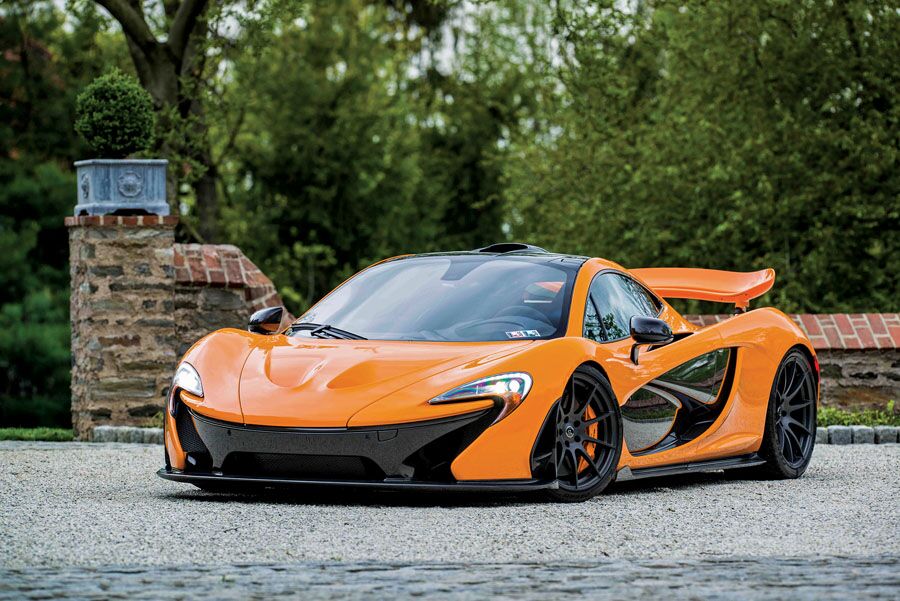- 3,799-cc DOHC twin-turbocharged V8 engine
- AC Permanent-Magnet Synchronous electric motor
- 903 bhp at 8,250 rpm
- 7-speed SSG transaxle with manual shifting mode
- Four-wheel Independent Proactive Adjustable Suspension
- Four-wheel carbon ceramic disc brakes
- One of very few P1s finished in striking McLaren Orange
- Extreme cutting-edge automotive engineering and design
- In practically new condition, with less than 1,200 miles
SCM Analysis
Detailing
| Vehicle: | 2014 McLaren P1 |
| Years Produced: | 2013–15 |
| Number Produced: | 375 |
| Original List Price: | $1,350,000 plus options |
| SCM Valuation: | Median to date, $2,039,000; high sale, $2,090,000 (this car) |
| Tune Up Cost: | $30,000 (including shipping to the U.K.) |
| Chassis Number Location: | Driver’s door sill |
| Club Info: | McLaren Owners Car Club, McLaren Owners Club (U.K.) |
| Website: | http://www.mclarenlife.com |
| Alternatives: | 2013 Ferrari LaFerrari, 2013 Porsche 918, 2016 Acura NSX |
| Investment Grade: | B |
This car, Lot 24, sold for $2,090,000, including buyer’s premium, at Bonhams’ Quail Lodge sale in Carmel, CA, on August 19, 2016.
The market for limited-production hypercars is a pocket universe in the collector car world. It seems to operate under a unique set of rules and values. Because the cars are often only months or a couple of years old — and almost always in as-new condition with very few miles — the calculus comes down to simple desirability. Is this car the flavor of the month, and has anything new come along to eclipse its glory?
The hybrid revolution
The middle years of this decade have been electrifying for the exotic car world — as manufacturers have jumped to rescue hybrid technology from its dowdy fuel-sipping origins and apply its techniques to performance. Electric motors generate their best torque at 0 rpm, and that’s something we can use.
So, more or less simultaneously, the McLaren P1, Ferrari LaFerrari and Porsche 918 hybrids all appeared with about the same performance envelope: roughly 900 horsepower, sub-3-second 0–60 mph, and a top speed somewhere around 200 mph. They also carried price tags in the low seven figures, except for the Porsche.
The 918 was the bargain of the bunch, starting at about $850,000. Next in line was the McLaren at $1,350,000, and predictably, the LaFerrari topped the lot at about $1,400,000 — if you could get one.
Production was limited to 918 examples of the 918 (cute), 499 LaFerraris, and just 375 of the McLaren P1.
Apart from their hybrid engines, the rest of the technology and gee-whiz in these hypercars is unremarkable — by exotic standards, anyway. Take your pick of active aerodynamics, carbon-ceramic brakes, and hyperleggera carbon-fiber monocoque bodies.
“All the usual refinements,” as Q might say.
Where’s the market?
When it comes to big-money sales, exotics like this McLaren don’t even move the needle. The big noise in Monterey this year was a vintage D-type Jag selling for 10 times the price of this modern marvel. Judging from the few comparable sales on record, the market for the McLaren P1 is barely steady.
Most instances of the P1 were delivered in 2014 and 2015, and the cars that came to America generally arrived in 2014. The subject car was one of those.
Last year in Monterey, two auctions had a P1. RM Sotheby’s made the first sale at $1,980,000 on August 14 (SCM# 6796755) and the next day Gooding & Company sold the other at $1,925,000 (SCM# 6795991). Bonhams had another P1 (Lot 12, The Scottsdale Auction) this past winter in Arizona, and it sold for $2,090,000 — exactly the same price as this sale.
The market for the P1 has been perfectly flat this year, especially when you include Bonhams’ buyer’s premium. Hammer price on the two Bonhams sales was around $1,730,000.
By comparison, Mecum sold a LaFerrari in Monterey for $4,700,000 (Lot S110), and a Porsche 918 did not sell at a high bid of $1,700,000 (Lot S112). In the exotic hybrid investment game, there’s now a clear front-runner.
Time marches on
The future for the McLaren P1 is probably okay — but just okay.
Remember, these aren’t cars one actually drives. Our subject P1 had covered just 1,200 miles since new, and that’s high mileage on a car of this type.
The LaFerrari that changed hands in Monterey had 211 miles on the clock, and Bonhams’ P1 in Scottsdale in January had fewer than 300 miles. While the McLaren P1 might be street-legal and track-ready according to McLaren, few buyers seem to actually take advantage of it.
As time goes on, newer cars will meet or exceed the P1 performance level for far less money.
The BMW i8 hybrid is sexy, yet it falls far short of the performance standard of other supercars. But this year, Acura entered the supercar sweepstakes with a limited-production reboot of its legendary NSX. The new car is a hybrid, all-wheel-drive exotic with almost all the zoot of the Europeans. The Acura makes just 573 horsepower, but its 0–60 mph time is three seconds flat, top speed is 191 mph, and it costs about $156,000. For that price difference, would you miss the extra 0.3 seconds in the 0–60 mph dash, or the last 15 mph of the top hybrid exotics? I didn’t think so.
The bottom line on this sale is that the seller likely did about as well as it’s possible to do this year.
He got his purchase price back, and depending on how the car was optioned, maybe he even made a little money. The buyer now faces an uncertain future, but chances are good that the car will trade again at even money in the next few years.
Time will tell if the P1 ever gains the panache of the McLaren F1, but for now we’ll call this car well sold. ♦
(Introductory description courtesy of Bonhams.)
